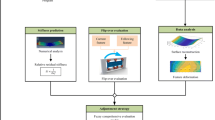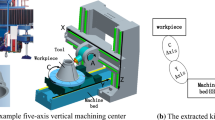Abstract
The real-time support variation of the machine tool is a source of systematic errors that cannot be ignored and has a great impact on the machining accuracy. The calculation and representation of moving support variation are important basis for improving machining accuracy. Different from the traditional data-based methods of static deformation measurement and compensation, this paper proposes a real-time continuous moving support deformation error model-based method to establish a systematic spatial-variably volumetric error model, which realizes the model decoupling of complex error sources of machine tools. The real-time deformation of moving support under multiple working conditions by FEM simulation is converted into the joint surface deformation of the moving system, and the translational and rotational position-dependent geometric errors (PDGE) are analyzed through the positional geometry of four sliders as joint surface, and the continuous moving variation errors along the single-axis and dual-axis motion space is generated. Further, based on the homogeneous transformation theory, the multi-axis 6-DOF PDGE are fused to construct a spatial-variably volumetric error model. In addition, this paper adopts a machining optimization method, which can efficiently identify the optimal machining space for the machine tool according to the machining features of the workpiece and the spatial-variably volumetric error model. In the case study, the proposed method is applied to a horizontal machining center, the detailed characterization of the spatial-variably error is given, and the optimal machining space is identified for different sample workpieces, which proves that it can effectively improve the machining accuracy of the machine tool.














Similar content being viewed by others
References
Guo SJ, Mei XS, Jiang GD (2019) Geometric accuracy enhancement of five-axis machine tool based on error analysis. Int J Adv Manuf Technol 105:137–153. https://doi.org/10.1007/s00170-019-04030-4
Zhou ZD, Gui L, Tan YG, Liu MY, Liu Y, Li RY (2017) Actualities and development of heavy-duty CNC machine tool thermal error monitoring technology. Chin J Mech Eng-En 30(5):1262–1281. https://doi.org/10.1007/s10033-017-0166-5
Zhao YQ, Mei JP, Niu WT (2021) Vibration error-based trajectory planning of a 5-dof hybrid machine tool. Robot Comput Integr Manuf 69:102095. https://doi.org/10.1016/j.rcim.2020.102095
Tian Y, Liu ZF, Xu XP, Wang G, Li QW, Zhou Y, Cheng JL (2019) Systematic review of research relating to heavy-duty machine tool foundation systems. Adv Mech Eng 11(1):1–16. https://doi.org/10.1177/1687814018806106
Rahman M, Heikkala J, Lappalainen K (2000) Modeling, measurement and error compensation of multi-axis machine tools. Part I: theory. Int J Mach Tools Manuf 40(10):1535–1546. https://doi.org/10.1016/S0890-6955(99)00101-7
Chen DJ, Zhang SW, Pan R, Fan JW (2018) An identifying method with considering coupling relationship of geometric errors parameters of machine tools. J Intell Manuf 36:535–549. https://doi.org/10.1016/j.jmapro.2018.10.019
Cheng Q, Wu C, Gu PH, Chang WF, Xuan DS (2013) An analysis methodology for stochastic characteristic of volumetric error in multiaxis CNC machine tool. Math Probl Eng 2013:1–12. https://doi.org/10.1155/2013/863283
Cong DC, Chinh BB, Jooho H (2015) Volumetric error model for multi-axis machine tools. Procedia Manuf 1:1–11. https://doi.org/10.1016/j.promfg.2015.09.023
Liu ZF, Xu JJ, Cheng Q, Zhao YS, Pei YH, Yang CB (2018) Trajectory planning with minimum synthesis error for industrial robots using screw theory. Int J Precis Eng Manuf 19(2):183–193. https://doi.org/10.1007/s12541-018-0021-3
Tian WJ, Gao WG, Zhang DW, Huang T (2014) A general approach for error modeling of machine tools. Int J Mach Tools Manuf 79:17–23. https://doi.org/10.1016/j.ijmachtools.2014.01.003
Xiang ST, Altintas Y (2016) Modeling and compensation of volumetric errors for five-axis machine tools. Int J Mach Tools Manuf 101:65–78. https://doi.org/10.1016/j.ijmachtools.2015.11.006
Khusainov RM, Sabirov AR, Mubarakshin II (2017) Study of deformations field in the working zone of vertical milling machine. Procedia Eng 206:1069–1074. https://doi.org/10.1016/j.proeng.2017.10.596
Cheng Q, Zhao HW, Zhao YS, Sun BW, Gu PH (2018) Machining accuracy reliability analysis of multi-axis machine tool based on Monte Carlo simulation. J Intell Manuf 29(1):191–209. https://doi.org/10.1007/s10845-015-1101-1
Xiang ST, Deng M, Li HM, Du ZC, Yang JG (2019) Cross-rail deformation modeling, measurement and compensation for a gantry slideway grinding machine considering thermal effects. Meas Sci Technol 30(6):065007. https://doi.org/10.1088/1361-6501/ab1232
Zhao ZW, Li YG, Liu CQ, Gao J (2020) On-line part deformation prediction based on deep learning. J Intell Manuf 31(3):561–574. https://doi.org/10.1007/s10845-019-01465-0
Liu CQ, Li YG, Shen WM (2018) A real time machining error compensation method based on dynamic features for cutting force induced elastic deformation in flank milling. Mach Sci Technol 22(5):766–786. https://doi.org/10.1080/10910344.2017.1402933
Wang P, Bai QS, Cheng K, Zhao L, Ding H (2022) The modelling and analysis of micro-milling forces for fabricating thin-walled micro-parts considering machining dynamics. Machines 10(3):217. https://doi.org/10.3390/machines10030217
Vaishnav S, Agarwal A, Desai KA (2020) Machine learning-based instantaneous cutting force model for end milling operation. J Intell Manuf 31(6):1353–1366. https://doi.org/10.1007/s10845-019-01514-8
Wang W, Zhang XY, Mei X (2016) Research on the mechanism of free surface contour error caused by the stiffness of feed system of five-axis machine tools. J Mech Eng 52:146. https://doi.org/10.3901/JME.2016.21.146
Law M, Altintas Y, Srikantha Phani A (2013) Rapid evaluation and optimization of machine tools with position-dependent stability. Int J Mach Tools Manuf 68:81–90. https://doi.org/10.1016/j.ijmachtools.2013.02.003
Chanal H, Guichard A, Blaysat B, Caro S (2022) Elasto-dynamic modeling of an over-constrained parallel kinematic machine using a beam model. Machines 10(3):200. https://doi.org/10.3390/machines10030200
Fan KC, Chen HM, Kuo TH (2012) Prediction of machining accuracy degradation of machine tools. Precis Eng 36(2):288–298. https://doi.org/10.1016/j.precisioneng.2011.11.002
Majda P (2012) Modeling of geometric errors of linear guideway and their influence on joint kinematic error in machine tools. Precis Eng 36(3):369–378. https://doi.org/10.1016/j.precisioneng.2012.02.001
Hwang J, Park CH, Kim SW (2010) Estimation method for errors of an aerostatic planar XY stage based on measured profiles errors. Int J Adv Manuf Technol 46:877–883. https://doi.org/10.1007/s00170-009-2008-9
Gu J, Agapiou JS (2019) Incorporating local offset in the global offset method and optimization process for error compensation in machine tools. Procedia Manuf 34:1051–1059. https://doi.org/10.1016/j.promfg.2019.06.091
Guo S, Tang SF, Zhang DS (2019) A recognition methodology for the key geometric errors of a multi-axis machine tool based on accuracy retentivity analysis. Complexity 2019:1–21. https://doi.org/10.1155/2019/8649496
Liang RJ, Wang ZQ, Chen WF, Ye WH (2021) Accuracy improvement for RLLLR five-axis machine tools: a posture and position compensation method for geometric errors. J Manuf Process 71:724–733. https://doi.org/10.1016/j.jmapro.2021.09.037
Zhang ZL, Cai LG, Cheng Q, Liu ZF, Gu PH (2019) A geometric error budget method to improve machining accuracy reliability of multi-axis machine tools. J Intell Manuf 30(2):495–519. https://doi.org/10.1007/s10845-016-1260-8
Zhang ZL, Yang YJ, Li GW, Qi Y, Yue C, Hu YL, Li Y (2022) Machining accuracy reliability evaluation of CNC machine tools based on the milling stability optimization. Int J Adv Manuf Technol 124:4057–4074. https://doi.org/10.1007/s00170-022-08832-x
Liu MY, Zhang X, Song H, Wang JL, Zhou SG (2018) Reconstruction algorithm for obtaining the bending deformation of the base of heavy-duty machine tool using inverse finite element method. Metrol Meas Syst 25(4):727–741. https://doi.org/10.24425/mms.2018.124878
Yang SM, Wu PF, Liu SL, Sun L, Zhao P, Long XY, Jiang ZD (2015) Deformation and thermal analysis of the guideways of a large scale aspheric machine tool. Procedia CIRP 27:181–186. https://doi.org/10.1016/j.procir.2015.04.063
Huang Z, Liu YC, Liao RJ, Cao XJ (2021) Thermal error modeling of numerical control machine tools based on neural network by optimized SSO algorithm. J NE Univ (Nat Sci) 42(11):1569–1578. https://doi.org/10.12068/j.issn.1005-3026.2021.11.008
Li B, Zhang Y, Wang LP, Li XK (2019) Modeling for CNC machine tool thermal error based on genetic algorithm optimization wavelet neural networks. J Mech Eng 55(21):215–220. https://doi.org/10.3901/JME.2019.21.215
Zhang H, Ding X, Dong X, Xiong M (2018) Optimal topology dsign of internal stiffeners for machine pedestal structures using biological branching phenomena. Struct Multidisc Optim 57:2323–2338. https://doi.org/10.1007/s00158-017-1862-6
Ding XH, Chen YL, Liu W (2010) Optimal design approach for eco-efficient machine tool bed. Int J Mech Mater Des 6(4):351–358. https://doi.org/10.1007/s10999-010-9142-2
Kidani S, Irino N, Maruyama S, Taniguchi K, Fujimori T, Soshi M, Yamazaki K (2020) Design and analysis of a built-in yaw measurement system using dual linear scales for automatic machine tool error compensation. J Intell Manuf 56:1286–1293. https://doi.org/10.1016/j.jmapro.2020.04.023
Oh JS, Bae ED, Keem T, Kim SW (2006) Measuring and compensating for 5-DOF parasitic motion errors in translation stages using Twyman–Green interferometry. Int J Mach Tools Manuf 46(14):1748–1752. https://doi.org/10.1016/j.ijmachtools.2005.12.002
Liu MY, Zhou F, Song H, Yang XL, Wang J (2020) Deformation reconstruction for a heavy-duty machine column through the inverse finite element method. IEEE Sens J 20(16):9218–9225. https://doi.org/10.1109/JSEN.2020.2989139
Acknowledgments
The authors strongly acknowledge the support from the Zhejiang Provincial Natural Science Foundation of China, the “Pioneer” R&D Program of Zhejiang, the Natural Science Foundation of Ningbo, and the Science and Technology Major Project of Ningbo. The authors also thank the reviewers and the editors for their insightful comments, which help improve the paper’s quality.
Funding
The work was supported by the Zhejiang Provincial Natural Science Foundation of China (LZ22E050008), the “Pioneer” R&D Program of Zhejiang (2023C01060), the Natural Science Foundation of Ningbo (2021J150), and the Science and Technology Major Project of Ningbo (2021Z110).
Author information
Authors and Affiliations
Contributions
All authors contributed to the study conception and design. Material preparation, data collection, and analysis were performed by Xiaojian Liu, Jiarun Xu, Yang Wang, and Lemiao Qiu. The first draft of the manuscript was written by Xiaojian Liu and Jiarun Xu and all authors commented on previous versions of the manuscript. All authors read and approved the final manuscript.
Corresponding authors
Ethics declarations
Competing interests
The authors declare no competing interests.
Additional information
Publisher’s Note
Springer Nature remains neutral with regard to jurisdictional claims in published maps and institutional affiliations.
Rights and permissions
Springer Nature or its licensor (e.g. a society or other partner) holds exclusive rights to this article under a publishing agreement with the author(s) or other rightsholder(s); author self-archiving of the accepted manuscript version of this article is solely governed by the terms of such publishing agreement and applicable law.
About this article
Cite this article
Liu, X., Xu, J., Wang, Y. et al. A systematic spatial-variably volumetric error model and machining optimization method based on continuous moving support variation of machine tool. Int J Adv Manuf Technol 129, 1189–1211 (2023). https://doi.org/10.1007/s00170-023-12302-3
Received:
Accepted:
Published:
Issue Date:
DOI: https://doi.org/10.1007/s00170-023-12302-3




